#islamic revolution
Text
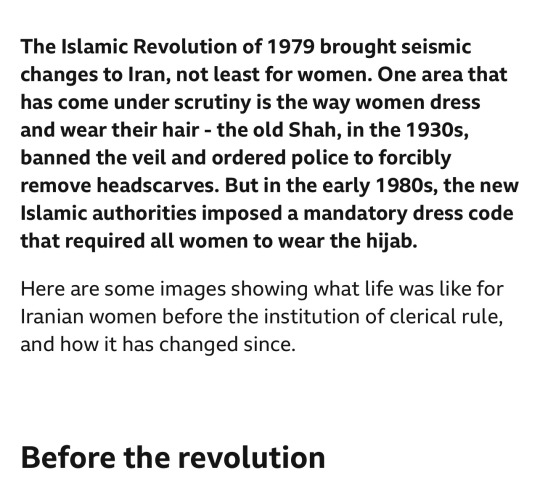

Studying at Tehran University in 1977: While many women were already in higher education at the time of the revolution, the subsequent years saw a marked increase in the number attending university. This was in part because the authorities managed to convince conservative families living in rural areas to allow their daughters to study away from home.
"They tried to stop women from attending university, but there was such a backlash they had to allow them to return," says Baroness Haleh Afshar, a professor of women's studies at the University of York who grew up in Iran in the 1960s.
"Some educated people left Iran, and the authorities realised in order to run the country they needed to educate both men and women."
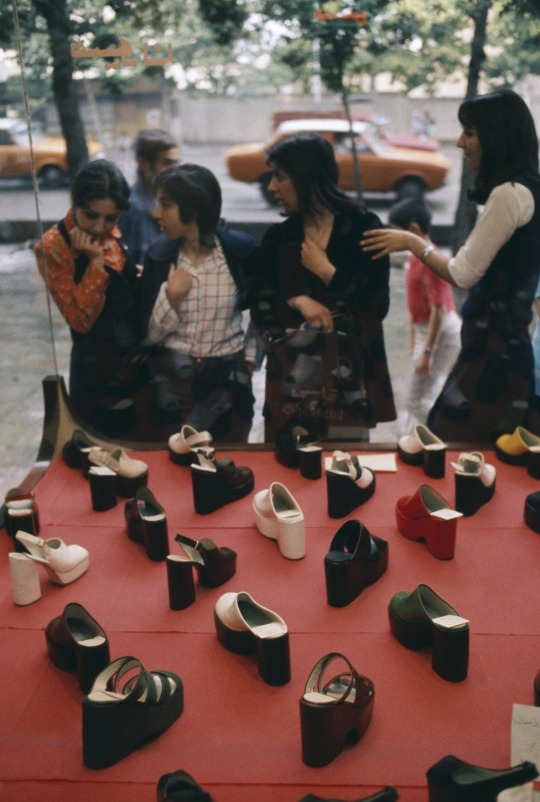
Window shopping in Tehran in 1976: Before the revolution, the hijab was already widely worn but many women also chose to don Western-style clothes, including tight-fitting jeans, miniskirts and short-sleeved tops. "The shoes haven't changed - and the passion for shoes is in all of us! Women in Iran are no different from women the world over, and going shopping is just a means for women to get away from every day stress," says Prof Afshar.
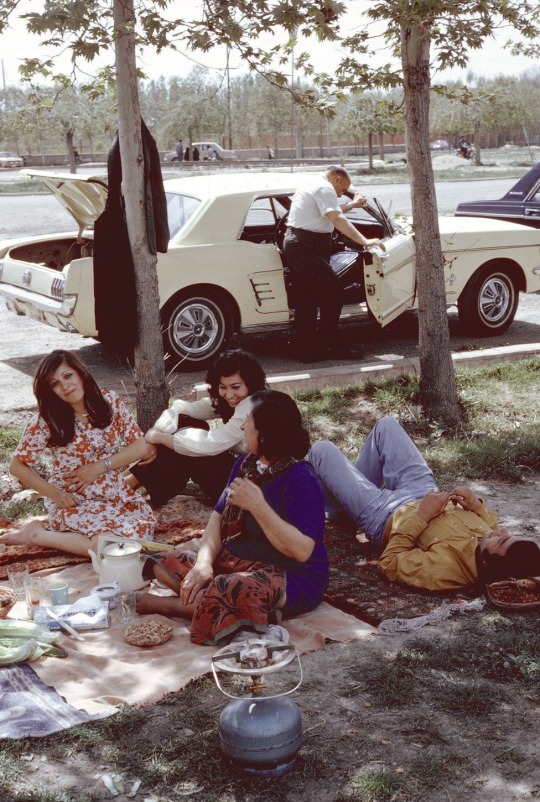
Friday picnic in Tehran in 1976: Families and friends tend to get together on Fridays, which are weekend days in Iran. "Picnics are an important part of Iranian culture and are very popular amongst the middle classes. This has not changed since the revolution. The difference is, nowadays, men and women sitting together are much more self-aware and show more restraint in their interactions," says Prof Afshar.
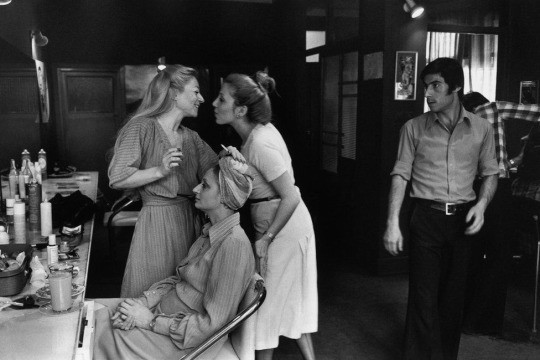
Hair salon in Tehran in 1977: "This is a scene you would no longer expect to see in Iran - but even after the Islamic Revolution, hairdressers continued to exist," says Prof Afshar. "Nowadays you wouldn't see a man inside the hairdressers - and women would know to cover up their hair as soon as they walked out the door. Some people may also operate secret salons in their own homes where men and women can mix."
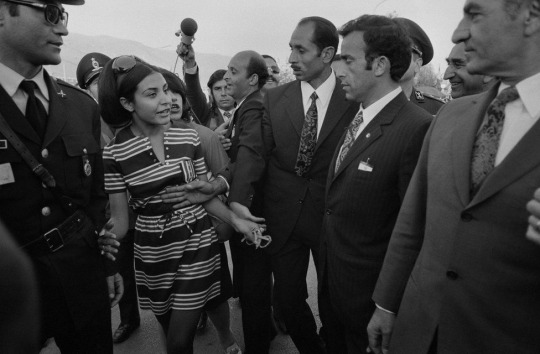
Bodyguards surround the shah in 1971: A young woman approaches Shah Mohammad Reza Pahlavi (far right) at a huge party marking the 2,500th anniversary of the Persian monarchy - the extravagance of the event was widely condemned by his left-wing and clerical opponents. "By this time, the shah was already very much disliked and some believe this image of excess and indulgence may have contributed to events leading up to the revolution eight years later," Prof Afshar explains.

Walking down a snowy street in Tehran in 1976: "You cannot stop women walking in the streets of Iran, but you wouldn't see this today - her earrings and make up so clearly on show," Prof Afshar says. "There is this concept of 'decency' in Iran - so nowadays women walking in the streets are likely to wear a coat down to her knees and a scarf."
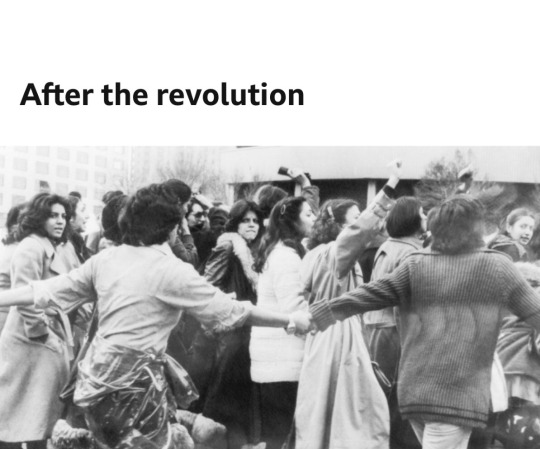
Women rally against the hijab in 1979: Soon after taking power, Iran's new Supreme Leader Ayatollah Ruhollah Khomeini decreed that all women had to wear the veil - regardless of religion or nationality. On 8 March - International Women's Day - thousands of women from all walks of life turned out to protest against the law.
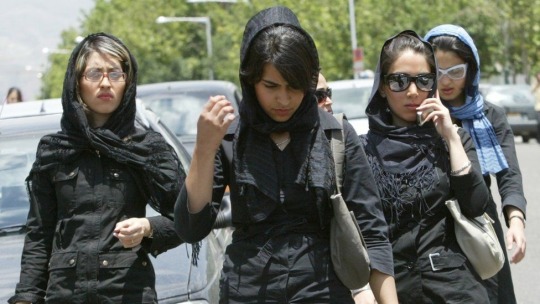
Walking in Tehran in 2005: Not all women in Iran opt to wear the black chador, a cloak that covers the body from head to toe and only leaves the face exposed. Many prefer to wear loosely fitted headscarves and coats. "The real question is how far back do you push your scarf? Women have their own small acts of resistance and often try as far as possible to push their scarves back," says Prof Afshar.

Watching football from a Tehran shopping centre in 2008: Though women were never officially banned from watching men's football matches in Iran, they are often refused entry to stadiums and some of those who have tried have been detained. Before the revolution, women were allowed to attend sporting events.
SEPTEMBER 2022: Protests, after the Morality Police beat, arrested and then murdered Mahsa Amini — for the “crime” of improperly wearing her hijab (source) (source)
#mahsa amini#jini emini#jini amini#iran#hijab#morality police#politics#islamic revolution#tehran#protests#bodily autonomy#womens rights#feminism#womanism#war on women#patriarchy#jhina emini
4K notes
·
View notes
Text

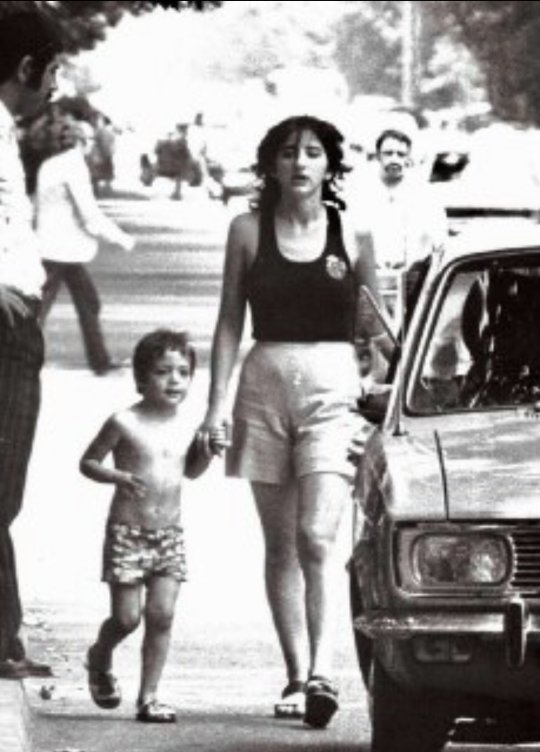
#Armin Navabi#islam#iran#islamic republic of iran#iranian regime#woman life freedom#morality police#acid attack#religion#islamic revolution#hijab#free from hijab#compulsory hijab#religion is a mental illness
173 notes
·
View notes
Text
☝️ Les gouvernements occidentaux n’ont pas rempli leur devoir
🎥⏸ Les gouvernements occidentaux n’ont pas rempli leur devoir. Certains ont dit certaines choses pour soutenir le peuple [de Gaza, mais dans la pratique, non seulement ils n'ont pas empêché [l’agresseur sioniste], mais beaucoup d'entre eux l'ont également aidé, en particulier les gouvernements arrogants et oppressifs des États-Unis et d'Angleterre. À travers les Incidents de Gaza, ces gouvernements occidentaux ont montré au monde la mauvaise nature de la civilisation occidentale.
Imam Khamenei, 10 avril 2024
Extraits du sermon de la prière de l'Aïd ul-Fitr 2024
#ali khamenei#ayatollah khamenei#iran#iranian#stand with iran#islamic revolution#gaza strip#free gaza#gaza under attack#gaza genocide#gaza under genocide#gazaunderattack#genocide in gaza#gazaunderfire#stand with gaza#save gaza#gaza#gaza free#gaza fights for freedom#palestine#free palestine#palestine will never die#palestine will be free#from the river to the sea palestine will be free#genocide in palestine#free free palestine#palestine genocide#i stand with palestine#palestinian genocide#palestinian resistance
20 notes
·
View notes
Text

Since these questions were sent at about the same time, I'm going to answer them together in the same post.
There's actually a great book that came out in 2020 about the geopolitical rivalry between Saudi Arabia and Iran that really heated up following the Islamic Revolution in Iran that overthrew the Shah in 1979 in favor of the theocracy of the Ayatollah Khomeini: Black Wave: Saudi Arabia, Iran, and the Forty-Year Rivalry That Unraveled Culture, Religion, and Collective Memory in the Middle East by Kim Ghattas (BOOK | KINDLE | AUDIO). It's one of the better books that I've read in the past few years and the ideal book to pick up if you're interested in the two most powerful Islamic nations of the Middle East.
Another good book that focuses on both countries is Andrew Scott Cooper's 2012 book The Oil Kings: How the U.S., Iran, and Saudi Arabia Changed the Balance of Power in the Middle East (BOOK | KINDLE | AUDIO).
SAUDI ARABIA
(I've read A LOT of books about Saudi Arabia over the past few years, so I could go on-and-on, but I'll try to limit myself to just a few recommendations!)
•The Kingdom: Arabia and the House of Sa'ud by Robert Lacey (BOOK | AUDIO)
•Inside the Kingdom: Kings, Clerics, Modernists, Terrorists, and the Struggle for Saudi Arabia by Robert Lacey (BOOK | KINDLE | AUDIO)
•Ibn Saud: The Desert Warrior Who Created the Kingdom of Saudi Arabia by Barbara Bray and Michael Darlow (BOOK | KINDLE | AUDIO)
•The Siege of Mecca: The 1979 Uprising at Islam's Holiest Shrine by Yaroslav Trofimov (BOOK | KINDLE | AUDIO)
•Saudi Arabia in the Nineteenth Century by R. Bayly Winder
•King Faisal of Saudi Arabia: Personality, Faith and Times by Alexei Vassiliev (BOOK | KINDLE)
•Kings and Presidents: Saudi Arabia and the United States Since FDR by Bruce Riedel (BOOK | KINDLE)
IRAN
•The Fall of Heaven: The Pahlavis and the Final Days of Imperial Iran by Andrew Scott Cooper (BOOK | KINDLE | AUDIO)
•America and Iran: A History, 1720 to the Present by John Ghazvinian (BOOK | KINDLE | AUDIO)
•The Iran-Iraq War by Pierre Razoux (BOOK | KINDLE)
•A History of Iran: Empire of the Mind by Michael Axworthy (BOOK | KINDLE | AUDIO)
•Iran: A Modern History by Abbas Amanat (BOOK | KINDLE | AUDIO)
•All the Shah's Men: An American Coup and the Roots of Middle East Terror by Stephen Kinzer (BOOK | KINDLE)
•Guests of the Ayatollah: The Iran Hostage Crisis: The First Battle in America's War with Militant Islam by Mark Bowden (BOOK | KINDLE | AUDIO)
•The Twilight War: The Secret History of America's Thirty-Year Conflict with Iran by David Crist (BOOK | KINDLE | AUDIO)
I'll stop there for now. I could list scores of books because I'm fascinated by the history of both countries, their place in the world, and their relations with one another and with the United States. I probably read a lot more about Saudi Arabia and Iran -- and their leaders -- than most people would expect. So I have even more suggestions if you need them...but hopefully this is a good start!
#Books#Book Recommendations#Book Suggestions#Iran#Saudi Arabia#History#Politics#Geopolitics#Middle East#Islam#Books about Iran#Books about Saudi Arabia#House of Saud#Iranian Revolution#Islamic Revolution#Shah of Iran#Ayatollah Khomeini
38 notes
·
View notes
Text
A woman cuts into her birthday cake in Tehran, Persia in 1973, 6 years before the Islam ruined everything.

#secular-jew#israel#jewish#judaism#israeli#jerusalem#diaspora#secular jew#secularjew#islam#Iran#Persia#Islamic revolution#khomeini#1973#1979
16 notes
·
View notes
Text
Imam Usama Abdulghani spoke at the "Al-Aqsa Flood" protest at the Ford Centennial Library in Dearborn, Michigan on October 14, 2023, saying: "We are lucky to be alive in the era of Imam Khomeini, the leader of the Islamic Revolution in Iran." He continued to say that October 7 was a "day of God," a "miracle come true," and he acknowledge IRGC Qods Force commander General Qassem Soleimani.
Abdulghani said that the "lions" are defending not only Palestine, but the nation of Muhmmad the Messenger. He added that the "honorable soldiers" of Palestine have chosen the only path to victory. Abdulghani asked: "How dare you compare Hamas to ISIS?" He added that Israel is worse than ISIS. Addressing the "friends of the Zionist occupiers," he said they should advise their friends that "the jig is up," that Israel is over, "the Titanic is sinking."
The event was organized the by Al-Quds Committee, and another speaker at the event was Islamic poet Hassan Salameh. For more about Dearborn, Michigan Imam Usama Abdulghani, see MEMRI TV clips nos. 9616, 9602, 8073, and 7284.
Usama Abdulghani: "We are lucky to be alive in the era of Imam Khomeini, where we witness these kinds of victories. Brothers and sisters, the operation Al-Aqsa Storm, that day when it took place was definitely what we call a 'one of the days of God.'
Video here.
12 notes
·
View notes
Text
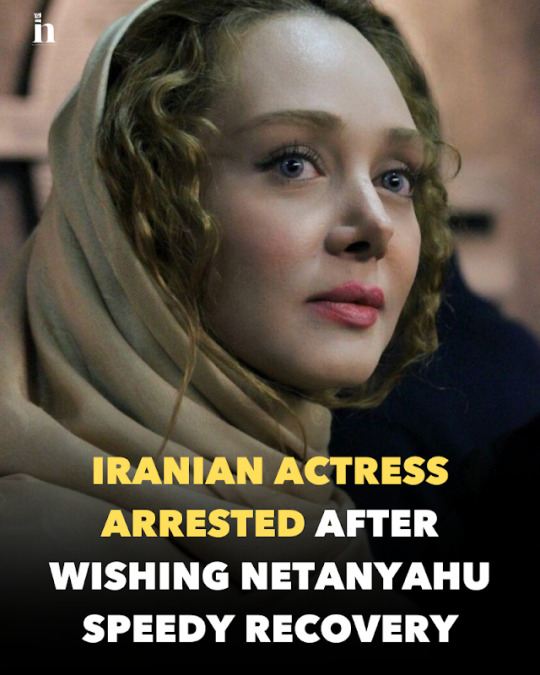
Iranian actress Shohreh Ghamar becomes the latest victim of Iran's Islamic regime after she simply wished Israeli Prime Minister Benjamin Netanyahu a speedy recovery. The Prime Minister had recently been in hospital to have a pacemaker fitted after another collapse.
Regardless of politics, it is just common decency to wish someone a speedy recovery when they face health challenges, but the Ayatollah and his fellow terrorists have no decency.
Since September of 2022, they have embarked on a campaign of terror against their own citizens for daring to support freedom and demanding the end of the failed, anti-civilisation Islamic Revolution.
Of course, there's a blatantly antisemitic motivation for this arrest. In order to help entrench the Islamic Revolution within society, the Iranian authorities need a scapegoat. Today, they can scapegoat Israel, but their real scapegoat is the Jews. If Ghamar had sent her wishes to an Arab leader, I doubt she would have been arrested. Her arrest was for treating a Jew as a fellow human being.
In Iran, Jews live a segregated life and have limited political influence. Many Iranian Jews have left the country. The Islamic regime encourages Jew-hatred, notably with a despicable Holocaust cartoon contest, promoting Nazi propaganda, and supporting extremist Jews who hate Israel (the Neturei Karta).
Story from Israeli activist Hananya Naftali
FREE SHOHREH GHAMAR!
#free shohreh ghamar#free iran#down with the islamic revolution#iran#iranian#benjamin netanyahu#israel#israeli#iran israel#ayatollah#islamic revolution#iranian history#iranian jews#jumblr
16 notes
·
View notes
Text
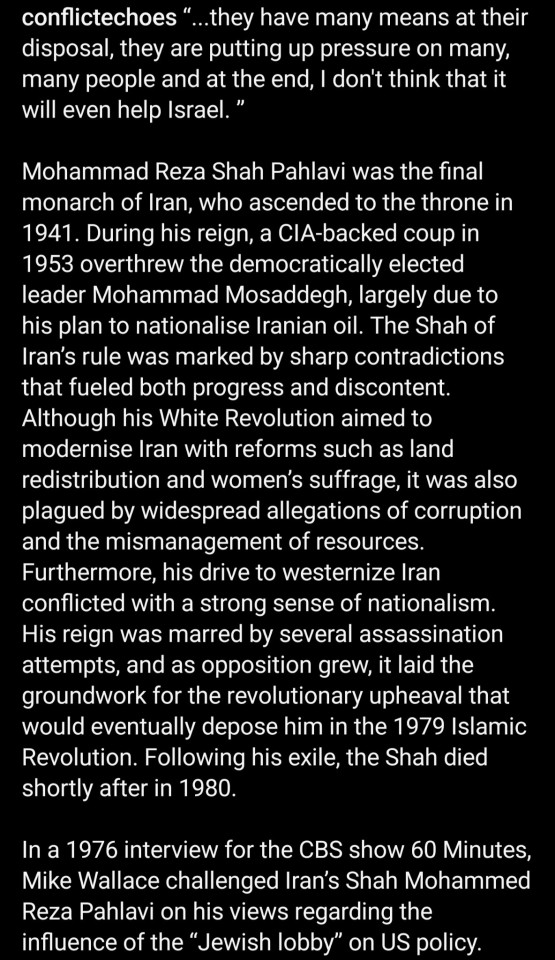
#follow the money#its always about oil#iranian oil#cia#shah pahlav#CIA backed coup#gee where have we seen that before?#the US is complicit in so many needless deaths not to mention genocide and war crimes#jewish lobby#60 minutes#apartheid#ethnic cleansing#israel is an apartheid state#seek truth#genocide#illegal occupation#israel is committing genocide#israeli war crimes#save palestine#free palestine 🇵🇸#israel is a terrorist state#iran#shah of Iran#white revolution#Islamic revolution#1979#its not paranoia if youre right#facts dont need conspiracy theories#seek the truth and share it#repost
2 notes
·
View notes
Text
Traditional values as a means of legitimizing the State

Since 1979 the Iranian state has introduced Sharia into the legislative branch of power as the legal basis for all spheres of life of the population of the Islamic state, which laws are equal for everyone, regardless of the social status or ethnicity of a citizen.
Accordingly, the state institution dealing with the specific task of implementing and monitoring this implementation of religious norms became “Islamic Revolution Committees” (کمیتههای انقلاب اسلامی), later incorporated into a security force called the Guidance Patrol or Morality Police (گشت ارشاد).
The most noticeable interweaving of this state structure, religious norms, and the daily life of Iranian citizens was a certain dress code, in particular, involving the wearing of a hijab for women (حجاب اسلامی).
However, how legitimate from the point of view of Islam is the very existence of morality police? The historical answer to this question is as follows: there was no state or institution forcing imputation of Sharia; instead, there was a muhtasib محتسب - an employee of a special organization (usually economic regulation) that monitored the implementation of Islamic moral norms in the market - بازار, which consist in encouraging what is approved and prohibiting what is condemned امور حسبی. In terms of scale, this institution cannot be compared with the power apparatus of the nation-state of modernity, which appeared in the Islamic world relatively late - with the arrival of the most developed European states in the Middle East - not earlier than the end of the 19th century.
In Iran itself - in 1979, and in its modern institutional form, in general, in 2005. Thus, the current system of force imputation of Sharia and “supervision” of its implementation is rather the so-called “invented tradition”, which serves to legitimize the expanded bureaucratic state mechanism, the need for which in a genuine traditional / religious society was not necessary, because there were family institutions and reputation, respect and piety, muhtasib. Therefore, the moral police in Iran is nothing but a "simulacrum", an anachronism, and an imperative of the triumph of the modern state, and not of the traditional Islamic society and theocracy.
I'd also add that traditionalist rhetoric is not only not canonical, but, being in the hands of the state system (any, and this applies not only to Iran), perverts the entire society, moving it away from other ideals set by the same Sharia and the Koran - the achievement of public well-being, "morals" society, etc.
6 notes
·
View notes
Text
Sayyidina Hussain - Prince of the 7 Heavens
Oh how valiantly Sayyidina Hussain fought, though outnumbered beyond sight, betrayed from the left to the right. But still the eyes and heart were submissive towards the Lord and His law.
The nobleman who became a legacy from Karbala till Yawm-al-Qiyamah. A shining example of the light of the luminance dispelling all illusions of the ignorants that were in darkness, just as clear as it turns from night to light.
Oh how he left the world to reunite, how bright was the flight of the one true knight.
Whom were those rejectors who began setting the fires and thought to fight, the worst of all creatures became the nobleman’s deniers.
The pure family blood became like gems and pearls scattered like how treasure is found and fought amongst those who know it’s worth.
You became the very reason the skies that year rained blood, just the thought of it makes one’s eyes flood.
How radiant was your countenance. The beauty that was kissed none other than the Rahmatalil-alamin (a mercy sent to all of creation), the finest of all, the best of all relations.
You are the mentor for every oppressed. The teacher for every depressed. The guider to every distressed.
Imam Hussain is the king of the martyred, the grand prince of this world and the holy prince of the Eternal seven Heavens.
#karbala#imam hussain#imam husayn#hazrat imam hussain#islamic history#islamic revolution#islam#islamic quotes#islamic reminders#islamic teachings#role model#welcome to islam#the day of ashura#muharram#prophet muhammad#learn something new#muslim ummah#sunni muslims#muslim quotes#free palestine#islamdaily#my role model#islamic blog#islamic new year#allahﷻ#sufism#sufi quotes#real stories#real life struggles#spiritual stories
3 notes
·
View notes
Text
How Cassettes Changed the World
Cassette tapes "fueled the Iranian revolution, helped pierce the Iron Curtain, and put human connection in the palm of our hands." On the On the Media podcast:
Simon Goodwin on his innovation to broadcast computer software over the radio back in 1983.
Computer programmer Fuxoft explains his role in 'Sneakernet,' which saw pirated material of all types smuggled into 1980s Czechoslovakia via cassette tape.
The role of cassette tapes in the Iranian Revolution.
Exiled Iranian radicals used cassette tapes to disseminate speeches from an elderly, obscure, exiled cleric named Ruholla Khomeini. The radicals figured Khomeini would be a useful puppet. That did not work out as planned.
#History of technology#technology history#cassette tapes#Iran#development#sneakernet#Czechoslovakia#us shooting#revolution#aruna irani#Islamic revolution#Ayatollah Khomeini#On the Media
1 note
·
View note
Text
Islamic Republic Will always Humiliate the Enemy
Ayatollah Khomeini
#ayatollah khomeini#iranian#stand with iran#iran#islamic revolution#islamic revolutionary guard corps#islamic republic of iran
8 notes
·
View notes
Text
Unrest across Iran continues under state’s extreme gender apartheid
In this Sept. 21, 2022, photo, Iranian demonstrators gather along a street in Tehran.
AFP via Getty Images
Haidar Khezri, University of Central Florida
Unrest continues to erupt across Iran following the death of a 22-year-old Kurdish Iranian woman, who died after being arrested and reportedly beaten by Iran’s morality police.
The Iranian force took Mahsa (Zhina) Amini into detention on Sept.…

View On WordPress
#Ayatollah Ali Khamenei#Corepaedia#corepaedianews#Iran#Iranian economy#Iranian politics#Iranian regime#Islamic Revolution#US-Iran US-Iran conflict#كوربيديا#كوربيديا للاخبار
0 notes
Text
Traditional values as a means of legitimizing the State

Since 1979 the Iranian state has introduced Sharia into the legislative branch of power as the legal basis for all spheres of life of the population of the Islamic state, which laws are equal for everyone, regardless of the social status or ethnicity of a citizen.
Accordingly, the state institution dealing with the specific task of implementing and monitoring this implementation of religious norms became “Islamic Revolution Committees” (کمیتههای انقلاب اسلامی), later incorporated into a security force called the Guidance Patrol or Morality Police (گشت ارشاد).
The most noticeable interweaving of this state structure, religious norms, and the daily life of Iranian citizens was a certain dress code, in particular, involving the wearing of a hijab for women (حجاب اسلامی).
However, how legitimate from the point of view of Islam is the very existence of morality police? The historical answer to this question is as follows: there was no state or institution forcing imputation of Sharia; instead, there was a muhtasib محتسب - an employee of a special organization (usually economic regulation) that monitored the implementation of Islamic moral norms in the market - بازار, which consist in encouraging what is approved and prohibiting what is condemned امور حسبی. In terms of scale, this institution cannot be compared with the power apparatus of the nation-state of modernity, which appeared in the Islamic world relatively late - with the arrival of the most developed European states in the Middle East - not earlier than the end of the 19th century.
In Iran itself - in 1979, and in its modern institutional form, in general, in 2005. Thus, the current system of force imputation of Sharia and “supervision” of its implementation is rather the so-called “invented tradition”, which serves to legitimize the expanded bureaucratic state mechanism, the need for which in a genuine traditional / religious society was not necessary, because there were family institutions and reputation, respect and piety, muhtasib. Therefore, the moral police in Iran is nothing but a "simulacrum", an anachronism, and an imperative of the triumph of the modern state, and not of the traditional Islamic society and theocracy.
1 note
·
View note
Text
The Man who bewildered the West
The Man who bewildered the West
TEHRAN – Imam Khomeini, the founding father of the Islamic Republic of Iran, continues to bewilder the West a terribly very very very very very very very very very very very very very long time after his demise on account of he led a revolution that continues unabated to all by the interim beneath the administration of his successor Ayatollah Seyed Ali Khamenei.
“Imam Khomeini is an ever-living…

View On WordPress
#Ayatollah Seyyed Ali Khamenei#bewildered#Imam Khomeini#Iran#Islamic Revolution#Leader of the Islamic Revolution#Man#West
0 notes
Text
Tomorrow will be one year since Mahsa Amini was murdered by Iranian morality police. After being pulled over for not wearing her hijab correctly, eyewitnesses at the police station say she was severely beaten.
Amini then fell into a coma and was transferred to hospital, where she died. Leaked medical scans indicate a cerebral haemorrhage or a stroke as the cause of death, very likely to be triggered by a severe beating.
One year on, Diako Alavi, a family friend of hers, writes this heartbreaking and powerful eulogy to this innocent woman.
In the last year, the Islamic Republic has shown itself to be one of the worst terrorist regimes on this planet. Many more Iranians have been killed both by riot police and by execution for the crime of protesting against the 1979 Islamic Revolution-- for that is really the heart of the protest movement.
The best way to honour Amini will be for the end of the Islamic Revolution and the punishment of all terrorists that upheld these barbaric law codes.
#mahsa amini#mahsa jina amini#iran#free iran#womens' rights#islamic revolution#down with the islamic revolution#down with the ayatollah#terrorism#crimes against humanity
5 notes
·
View notes